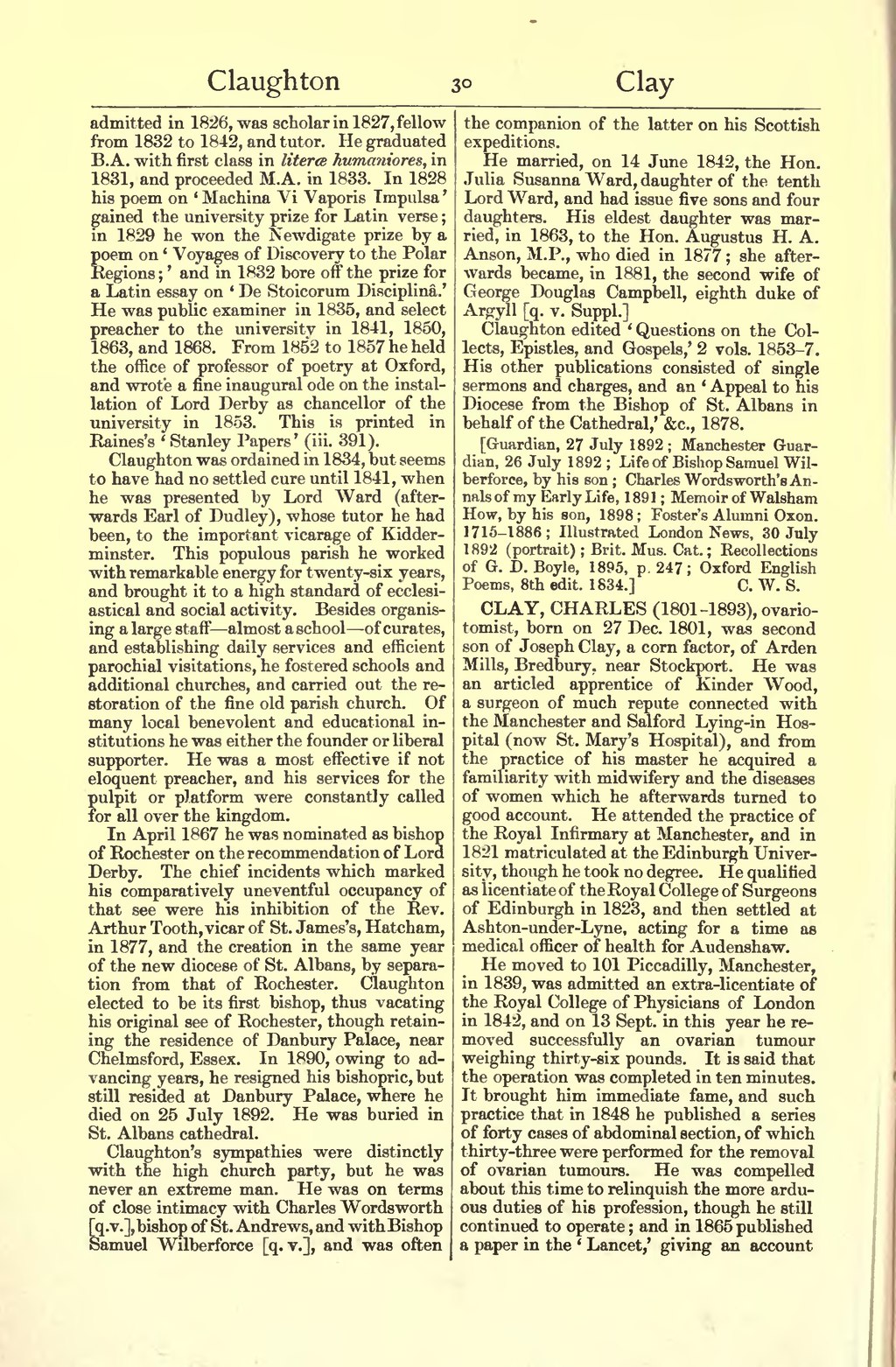admitted in 1826, was scholar in 1827, fellow from 1832 to 1842, and tutor. He graduated B. A. with first class in literæ humaniores, in 1831, and proceeded M.A. in 1833. In 1828 his poem on 'Machina Vi Vaporis Impulsa' gained the university prize for Latin verse; in 1829 he won the Newdigate prize by a poem on 'Voyages of Discovery to the Polar Regions;' and in 1832 bore off the prize for a Latin essay on 'De Stoicorum Disciplina.' He was public examiner in 1835, and select preacher to the university in 1841, 1850, 1863, and 1868. From 1852 to 1857 he held the office of professor of poetry at Oxford, and wrote a fine inaugural ode on the installation of Lord Derby as chancellor of the university in 1853. This is printed in Raines's 'Stanley Papers' (iii. 391).
Claughton was ordained in 1834, but seems to have had no settled cure until 1841, when he was presented by Lord Ward (afterwards Earl of Dudley), whose tutor he had been, to the important vicarage of Kidderminster. This populous parish he worked with remarkable energy for twenty-six years, and brought it to a high standard of ecclesiastical and social activity. Besides organising a large staff almost a school of curates, and establishing daily services and efficient parochial visitations, he fostered schools and additional churches, and carried out the restoration of the fine old parish church. Of many local benevolent and educational institutions he was either the founder or liberal supporter. He was a most effective if not eloquent preacher, and his services for the pulpit or platform were constantly called for all over the kingdom.
In April 1867 he was nominated as bishop of Rochester on the recommendation of Lord Derby. The chief incidents which marked his comparatively uneventful occupancy of that see were his inhibition of the Rev. Arthur Tooth, vicar of St. James's, Hatcham, in 1877, and the creation in the same year of the new diocese of St. Albans, by separation from that of Rochester. Claughton elected to be its first bishop, thus vacating his original see of Rochester, though retaining the residence of Danbury Palace, near Chelmsford, Essex. In 1890, owing to advancing years, he resigned his bishopric, but still resided at Danbury Palace, where he died on 25 July 1892. He was buried in St. Albans cathedral.
Claughton's sympathies were distinctly with the high church party, but he was never an extreme man. He was on terms of close intimacy with Charles Wordsworth [q.v.], bishop of St. Andrews, and with Bishop Samuel Wilberforce [q. v.], and was often the companion of the latter on his Scottish expeditions.
He married, on 14 June 1842, the Hon. Julia Susanna Ward, daughter of the tenth Lord Ward, and had issue five sons and four daughters. His eldest daughter was married, in 1863, to the Hon. Augustus H. A. Anson, M.P., who died in 1877; she afterwards became, in 1881, the second wife of George Douglas Campbell, eighth duke of Argyll [q. v. Suppl.]
Claughton edited 'Questions on the Collects, Epistles, and Gospels,' 2 vols. 1853-7. His other publications consisted of single sermons and charges, and an 'Appeal to his Diocese from the Bishop of St. Albans in behalf of the Cathedral,' &c., 1878.
[Guardian, 27 July 1892; Manchester Guardian, 26 July 1892; Life of Bishop Samuel Wilberforce, by his son; Charles Wordsworth's Annals of my Early Life, 1891; Memoir of Walsham How, by his son, 1898; Foster's Alumni Oxon. 1715-1886; Illustrated London News, 30 July 1892 (portrait); Brit. Mus. Cat.; Recollections of G. D. Boyle, 1895, p. 247; Oxford English Poems, 8th edit. 1834.]
CLAY, CHARLES (1801–1893), ovariotomist, born on 27 Dec. 1801, was second son of Joseph Clay, a corn factor, of Arden Mills, Bredbury. near Stockport. He was an articled apprentice of Kinder Wood, a surgeon of much repute connected with the Manchester and Salford Lying-in Hospital (now St. Mary's Hospital), and from the practice of his master he acquired a familiarity with midwifery and the diseases of women which he afterwards turned to good account. He attended the practice of the Royal Infirmary at Manchester, and in 1821 matriculated at the Edinburgh University, though he took no degree. He qualified as licentiate of the Royal College of Surgeons of Edinburgh in 1823, and then settled at Ashton-under-Lyne, acting for a time as medical officer of health for Audenshaw.
He moved to 101 Piccadilly, Manchester, in 1839, was admitted an extra-licentiate of the Royal College of Physicians of London in 1842, and on 13 Sept. in this year he removed successfully an ovarian tumour weighing thirty-six pounds. It is said that the operation was completed in ten minutes. It brought him immediate fame, and such practice that in 1848 he published a series of forty cases of abdominal section, of which thirty-three were performed for the removal of ovarian tumours. He was compelled about this time to relinquish the more arduous duties of his profession, though he still continued to operate; and in 1865 published a paper in the 'Lancet,' giving an account
